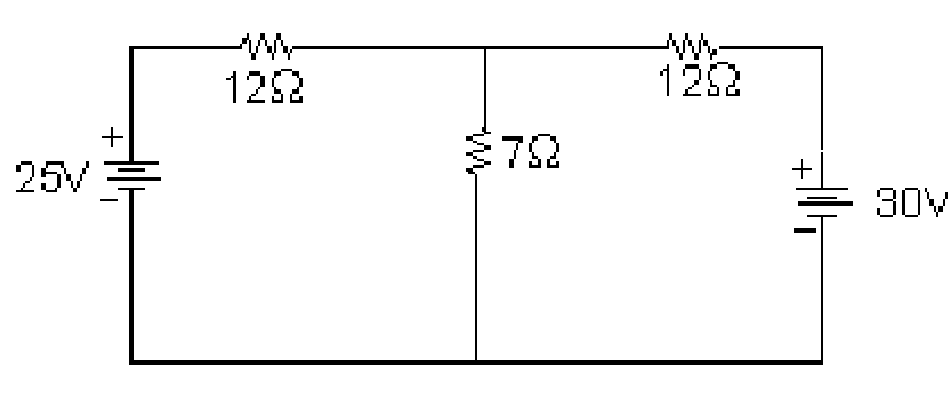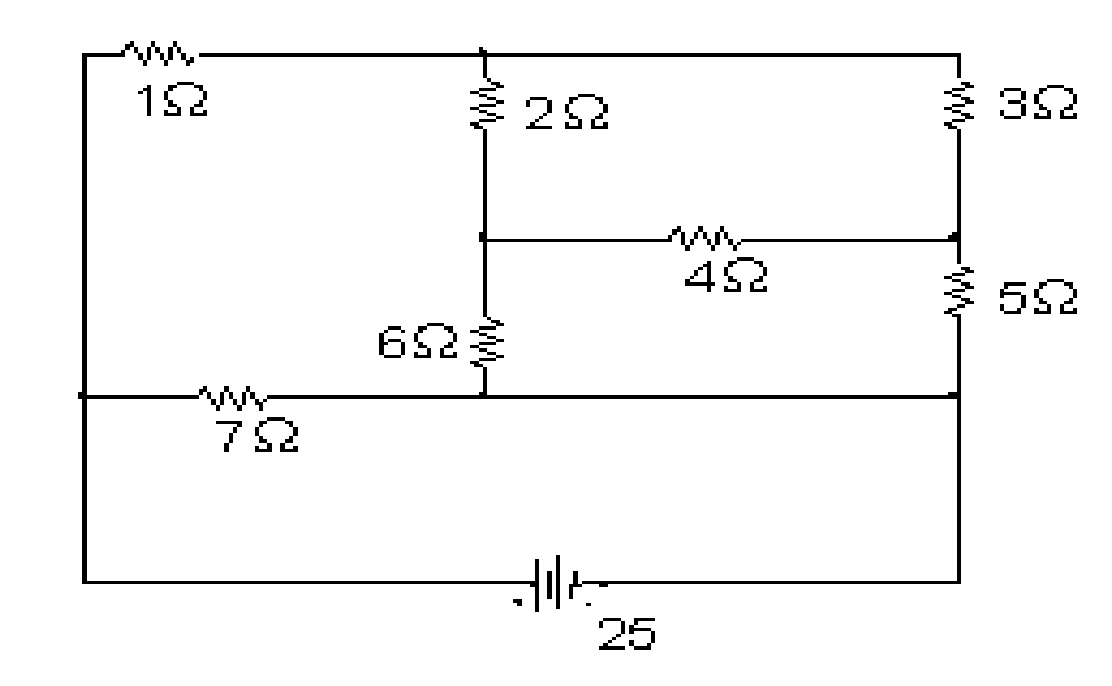Jawaharlal Nehru Technological University Kakinada 2008 B.Tech Computer Science Information Technology I Regular s, /E Basic Electrical Engineering - Question Paper
Code No: 07A1EC07 Set No. 1
I B.Tech Regular Examinations, May/Jun 2008 BASIC ELECTRICAL ENGINEERING ( Common to Computer Science & Engineering, Information Technology and Computer Science & Systems Engineering)
Time: 3 hours Max Marks: 80
Answer any FIVE Questions All Questions carry equal marks k k k k k
1. Explain the following terms:
|
(a) |
Charge |
|
(b) |
Electric potential |
|
(c) |
Potential difference |
|
(d) |
Electric current |
|
(e) |
Resistance |
|
(f) |
Conductance |
|
(g) |
Power |
|
(h) |
Electrical energy. |
[2+2+2+2+2+2+2+2]
2. Using Thevenins theorem, find the current through the 7Q resistor as shown in figure 2. [16]
 |
|
Figure 2 |
3. (a) State and explain faradays laws of electromagnetic induction.
(b) Write short notes on Lenzs law.
(c) A coil of 1000 turns of wire uniformly wound on a non-magnetic ring of mean diameter 40 cm and cross-sectional area 20 sq.cm. Calculate
i. The inductance of the coil.
ii. The energy stored in the magnetic field when the coil is carrying a current of 15A.
iii. The emf induced in the coil if this current is completely interrupted in
0.01 second. [5+3+8]
4. (a) Explain the terms:
i. In-phase vectors
ii. Lead-Lag vectors.
(b) Calculate the current, power, power factor and voltage across the resistor of 8 Q in series with a inductor of 20H and a capacitor of 14 excited by an AC supply of 110 V. [6+10]
5. (a) The full load voltage drop in a single phase transformer is 3% and 6% re
spectively due to resistance and leakage reactance. The full load ohmic loss is equal to the iron loss. Calculate:
i. The efficiency on full load at unity p.f
ii. The full load p.f at which the voltage drop is maximum
iii. The load p.f at which the voltage drop is zero.
(b) A 200 / 400V, 50Hz 1 phase transformer on test gave following readings:
O.C (l.v): 200V, 0.7A, 70W, S.C (h.v): 15V, 10A, 80W. Find voltage regulation at 0.8 p.f lagging at full load. [8+8]
6. (a) What are the differences between a DC shunt motor and a DC series motor.
(b) Why a DC series motor cannot be started on no load? Explain.
(c) Explain the principle of torque production in a DC motor. [6+5+5]
7. (a) Give the constructional features of a synchronous motor.
(b) Explain the working of a synchronous motor. [8+8]
8. (a) Bring out the advantages and disadvantages of MI and MC instrument.
(b) Bring out the differences between various methods of producing controlling torque. [8+8]
k k k k k
I B.Tech Regular Examinations, May/Jun 2008 BASIC ELECTRICAL ENGINEERING ( Common to Computer Science & Engineering, Information Technology and Computer Science & Systems Engineering)
Time: 3 hours Max Marks: 80
Answer any FIVE Questions All Questions carry equal marks k k k k k
1. Explain the following terms:
Charge
(a
(b
(c
(d
(e
(f
(g
(h
2. (a (b
Electric potential Potential difference Electric current Resistance Conductance Power
Electrical energy. [2+2+2+2+2+2+2+2]
State Thevenins theorem. Discuss its significance on the network theory.
For the circuit shown in figure 2b, find the resistance between the terminals A and B.
 |
|
Figure 2b |
3. An iron ring has a mean diameter of 25 cm and a cross-sectional area of 4 sq.cm. It is wound with a coil of 1200 turns. An air gap of 1.5 mm width is cut in the ring. Determine the current required in the coil to produce a flux of 0.48 mwb in the air gap if the relative permeability of the iron under these conditions is 800. Neglect magnetic leakage and fringing. [16]
4. (a) Explain the behaviour of AC through R-C series circuit.
(b) A resistor carries two alternative currents having same frequency and phase and having the same peak value of 20A. One is sinusoidal and the other is rectangular in waveform. Find the RMS value of the resultant current.[6+10]
5. (a) Draw a no load phasor diagram and explain it.
(b) Enumerate the various losses in a transformer. How can these losses be minimized. [6+10]
6. (a) Based on the type of excitation classify the DC generators.
(b) A 4 pole DC generator with a shunt field resistance of 100 Q and armature resistance of 1 Q has 378 wave connected conductors in its armature. The flux per pole is 0.02 Wb. If a load resistance of 10 Q is connected across the Armature terminals and the generator is driven at 1000 rpm, calculate the power absorbed by the load. [6+10]
7. (a) Why synchronous motors are not self starting. Explain.
(b) What are the various methods of making synchronous motors self starting? Explain. [6+10]
8. Explain with neat sketch the construction and working of a MI voltmeter and MC voltmeter. [8+8]
I B.Tech Regular Examinations, May/Jun 2008 BASIC ELECTRICAL ENGINEERING ( Common to Computer Science & Engineering, Information Technology and Computer Science & Systems Engineering)
Time: 3 hours Max Marks: 80
Answer any FIVE Questions All Questions carry equal marks k k k k k
1. (a) A copper wire of diameter 1cm has resistance of 0.15Q. It was drawn under
pressure so that its diameter was reduced to 50%. What is the new resistance of the wire?
(b) State and explain Faradays law of electromagnetic induction. [10+6]
2. Explain the following terms:
(a) Graph
(b) Tree
(c) Co-tree
(d) Oriented graph
(e) Sub graph
(f) Link
(g) Short circuit
(h) Open circuit. [2+2+2+2+2+2+2+2]
3. Define the following:
(a) Magnetic field
(b) Magnetic circuit
(c) Magnetic flux
(d) Magnetic flux density
(e) MMF
(f) Reluctance
(g) Magnetic field strength
(h) Permeability. [16]
4. (a) Calculate:
i. The admittance Y
ii. The conductance G and
iii. Susceptance B of a circuit consisting of a resistor of 20 Q in series with an inductor of 0.3 H, when the frequency is 60 Hz.
(b) A 20 Q resistance and 30 mH inductance are connected in series and the circuit is fed from a 230 V, 50 Hz AC supply. Find
i. Reactance across the inductance, impedance, admittance, current
ii. Voltage across the resistance
iii. Voltage across the inductance
iv. Real, reactive and active powers
v. Power factor [8+8]
5. (a) A 100KVA 1 phase transformer has full load primary current of 400A and
total resistance referred to primary is 0.006 Q. If the iron loss amounts to 500W, find the efficiency at full load and half load at
i. Unity power factor
ii. 0.8 power factor.
(b) A 120 KVA, 2000 / 200V 1 phase transformer takes a current of 50 A and 2400 W at 100V when the low voltage winding is short circuited. Determine the load voltage and % regulation when delivering full load current at 0.8p.f lagging, the supply voltage being 2000V. [8+8]
6. (a) Derive the expression for the armature torque and shaft torque of a DC motor.
(b) The armature of a 6 pole, DC shunt motor takes 300 A at the speed of 400 revolutions per minute. The flux per pole is 75 mWb. The number of armature turns is 500. The torque lost in windage, friction and iron losses can be assumed a 2.5%. Calculate [6+10]
i. Torque developed by the armature
ii. Shaft torque
iii. Shaft power in KW.
7. (a) Give the constructional features of a synchronous motor.
(b) Explain the working of a synchronous motor.
[8+8]
[8+8]
8. What is meant by underdamping and critical damping? Explain.
I B.Tech Regular Examinations, May/Jun 2008 BASIC ELECTRICAL ENGINEERING ( Common to Computer Science & Engineering, Information Technology and Computer Science & Systems Engineering)
Time: 3 hours Max Marks: 80
Answer any FIVE Questions All Questions carry equal marks
1. Find the current through and the voltage across all the elements by using Kirchoffs laws as shown in figure 1. [16]
 |
|
Figure 1 |
2. (a) Give a detailed comparison of series and parallel circuit.
(b) What are the applications, merits and demerits of a series circuit?
(c) What are the applications and advantages of a parallel circuit? [6+5+5]
3. (a) Define mutual inductance. Obtain an expression for the same.
(b) The number of turns in a coil is 250 when a current of 2A flows in this coil, the flux in the coil is 0.3 mwb. When this current is reduced to zero in 2 ms, the voltage induced in a coil lying in the vicinity of coil is 63.75 V. If the coefficient of coupling between the coils is 0.75, find self inductances of two coils, mutual inductance and no of turns in the second coil. [6+10]
4. Derive an expression for RMS value, average value, form factor and peak factor for the
(a) Square waveform
(b) Trapezoidal waveform.
[8+8]
5. (a) What is the difference between an ideal transformer and a practical transformer?
(b) Derive the approximate equivalent circuit of a 1 phase transformer. [4+12]
6. (a) Derive the expression for the armature torque and shaft torque of a DC motor.
(b) The armature of a 6 pole, DC shunt motor takes 300 A at the speed of 400 revolutions per minute. The flux per pole is 75 mWb. The number of armature turns is 500. The torque lost in windage, friction and iron losses can be assumed a 2.5%. Calculate [6+10]
i. Torque developed by the armature
ii. Shaft torque
iii. Shaft power in KW.
7. (a) How is a rotating magnetic field produced in a three phase induction motor?
Explain in detail with relevant phasors.
(b) Give in detail the operating principle of a three phase induction motor. [8+8]
8. With a neat sketch, explain the principle of operation of the repulsion type and attraction type moving iron instruments. [8+8]
2 of 2
|
Attachment: |
| Earning: Approval pending. |
